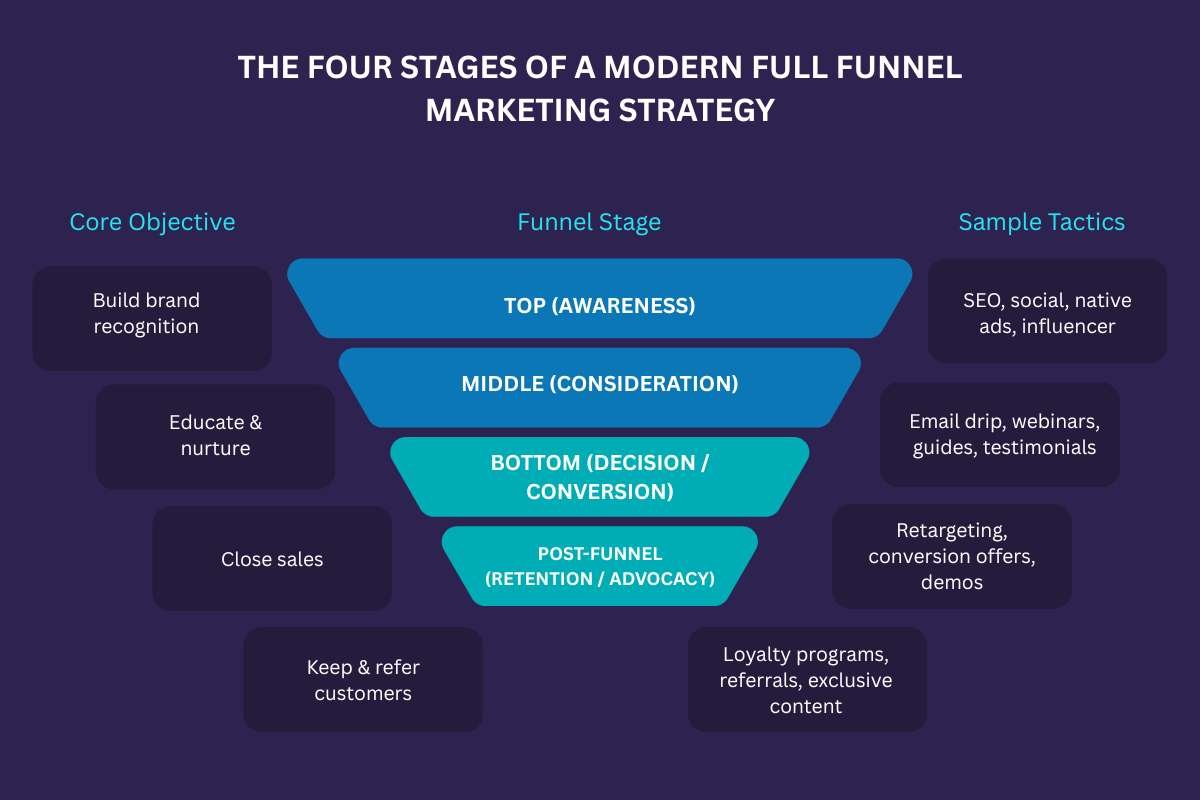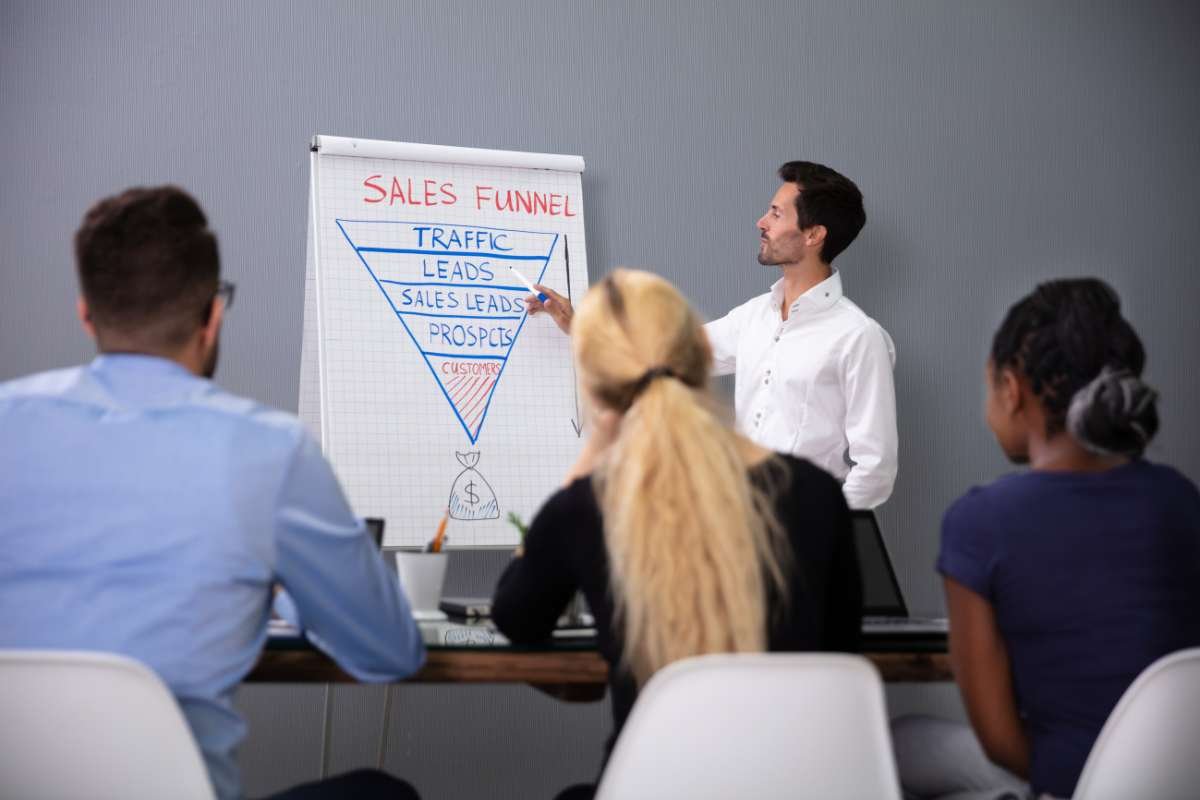Every brand dreams of one particular magic moment. The instant when a stranger sees an ad, clicks a button, and becomes a loyal customer. But here’s the hard truth: it rarely works that way.
In reality, 96% of people who land on your website aren’t ready to buy. They need time, trust, and touchpoints before they commit.
This is where Full Funnel Marketing is transforming the game. It sparks curiosity at the top, nurtures confidence in the middle, seals the deal at the bottom, and then turns buyers into advocates who carry your story forward.
The best companies in 2025 know that the funnel is no longer optional but the architecture of growth. In this piece, we’ll break down how full funnel marketing works, why it drives higher ROI than fragmented campaigns, and how you can put it into practice with proven strategies and examples.
What is Full Funnel Marketing? A Business Growth Perspective
At its core, Full Funnel describes a strategy that spans every stage of the customer journey—top, middle, bottom, and beyond, so prospects never feel disconnected from the brand. Amazon defines it as “crafting a strategy across all marketing channels and touchpoints in the customer journey.”
Companies that adopt full-funnel marketing can generate 15–20% higher ROI by connecting brand building with performance marketing.
Contrast that with siloed campaigns: many brands excel in awareness but fail to nurture mid-funnel leads. A funnel marketing strategy ensures those gaps vanish, so leads move smoothly toward purchase.
The Four Stages of a Modern Full Funnel Marketing Strategy
Below is a funnel map that shows each stage and its role in funnel marketing:

| Funnel Stage | Customer Mindset | Core Objective | Sample Tactics |
| Top (Awareness) | “Who are you?” | Build brand recognition | SEO, social, native ads, influencer |
| Middle (Consideration) | “Should I trust you?” | Educate & nurture | Email drip, webinars, guides, testimonials |
| Bottom (Decision / Conversion) | “Let me purchase” | Close sales | Retargeting, conversion offers, demos |
| Post-Funnel (Retention / Advocacy) | “I’m with you.” | Keep & refer customers | Loyalty programs, referrals, exclusive content |
In a genuine full funnel, each stage links seamlessly to the next. For instance, a social ad might lead a user to a gated eBook (middle funnel), then to a retargeted offer (bottom funnel), and finally to a loyalty program (post-funnel).
1. Top of Funnel (TOFU): Attract Broad Interest
At the TOFU stage, prospects may not be familiar with your brand or might just have a vague idea. Your goal is to awaken curiosity and build trust. Speak about their pain, not your product.
- Example: A case in point: Smartling’s content strategy drove $3.7M in pipeline value via organic channels. Their approach focused heavily on education and content rather than outright sales messaging.
- Effective TOFU Tactics:
- Keyword-based SEO targeting broader pain-point queries
- Social media storytelling and community engagement
- Native ads linked to insightful content (not sales pages)
- Influencer partnerships with aligned audiences
- Quizzes, polls, and videos that spark interest
- Metrics to Watch: Impressions, CTR, site visits, new audience reach — these tell you how well your net is casting.
2. Middle of Funnel (MOFU): Nurture, Educate, Build Preference

Once people enter your funnel (via content, social ad, or opt-in), MOFU is where the shift happens: from wonder to consideration. Now you must earn trust.
- Example: Smartling’s content-driven pipeline growth portrays how mid-funnel efforts pay off when grounded in expertise.
- Powerful MOFU Tactics:
- E-books, guides, comparison documents
- Webinars and training sessions
- Segmented email drip campaigns
- Testimonials, case studies, reviews
- Interactive tools, calculators, and product comparisons
- Behavioral Insights: Personalized CTAs outperform generic ones. For instance, marketing sources report that personalized CTAs convert 202% better than default ones.
- Metrics to Watch: Cost per lead, lead quality score, engagement rate, webinar attendance, and lead-to-MQL conversion.
3. Bottom of Funnel (BOFU): Convert Intent into Purchase
At BOFU, leads are nearly ready to buy. They’ve seen your content, engaged with your brand, and now need that last push.
- BOFU Tactics that Work:
- Retargeting campaigns for users who showed interest
- Emails with special offers, discounts, or urgency
- Demos, trials, consults
- Seamless checkout/purchase experiences
- Live chat or support to handle objections
- Metrics to Watch: Conversion rate, customer acquisition cost (CAC), average purchase value.
4. Post-Funnel (Retention & Advocacy): Keep Them Close, Turn Them into Champions
The work doesn’t stop after the sale. Post-funnel efforts help reduce churn, encourage repeat purchases, and turn customers into brand advocates.
- Best Practices:
- Loyalty programs or exclusive tiers
- Referral incentives (reward both referrer and referee)
- Survey feedback loops to learn customer pain
- Upsell / cross-sell via personalized recommendations
- Why It Matters: It’s cheaper to retain a customer than to acquire a new one. Strong retention also multiplies lifetime value and drives word-of-mouth growth.
Strategic Architecture of Enterprise Full Funnel Marketing
Enterprise-level funnel marketing requires alignment across teams, scalable processes, and data linkages.
- Unified teams & KPIs: Combine brand and performance teams into a single operating model—so they don’t compete, they complement.
- Media mix modeling: Distribute budget across stages intelligently. For example, a brand ad on TV may boost email conversion later.
- Investment mindset: Some leaders suggest treating marketing as capital allocation—cut inefficiencies, reinvest into high-ROI full funnel channels.
Because modern consumers jump around the funnel, architecture must account for nonlinearity. Some will skip awareness and jump directly to consideration, while others may languish mid-funnel for weeks.
Mapping the Tech Stack to the Funnel
You can’t do effective full funnel marketing without tech that connects the dots. Here’s how:
- Top funnel: Demand generation tools, DSPs, social ad platforms
- Middle funnel: Marketing automation, email platforms, CRM
- Bottom funnel: Retargeting platforms, conversion tracking, checkout optimization
- Post funnel: Loyalty platforms, referral systems, customer analytics
Amazon Ads, for example, now offers unified measurement across their ad channels, allowing marketers to see how top-funnel efforts drive mid-funnel engagement.
When your tech stack aligns with your funnel mapping, you reduce friction, improve attribution, and ensure funnel marketing works in practice, not just theory.
Advanced Attribution & Performance Measurement
Full funnel marketing demands you connect dots: top-funnel investments influence bottom-funnel results.
Advanced attribution models:
- Multi-touch attribution: giving weight to every touchpoint
- Incrementality testing: measuring lift when a tactic is present vs absent
- Media mix modeling: relating spend allocation across stages
Full funnel marketing helps brands better understand how awareness spend (e.g., TV) boosts performance channels (e.g., email) via linked systems.
Tools like Amazon Marketing Cloud or unified dashboards can surface insights such as which upper funnel creatives stimulate middle funnel clicks.
Budget Allocation Framework for Full Funnel Marketing
How much to invest in each stage? It depends, but common frameworks help.
- Many brands allocate a 30–50% budget to upper funnel, 20–40% to middle, and 20–30% to bottom + post-funnel.
- Shift budget toward stronger funnel stages to increase overall ROI by 15–20%.
- Use test budgets early to discover what works, then scale funnel marketing tactics that deliver lift.
Don’t just pour all the budget into bottom-of-funnel ads. That myopia breaks the full funnel marketing and kills long-term growth.
Industry-Specific Full Funnel Playbooks
| Industry | Top Funnel Tactics | Middle Funnel | Bottom Funnel / Post |
| E-commerce / Amazon | Sponsored Brand, Display Ads, video ads | Brand storefront, product comparison content | Sponsored Products, retargeting, Subscribe & Save |
| SaaS / B2B | Thought leadership content, LinkedIn ads | Webinars, free trials, case studies | Account-based retargeting, demos, onboarding & retention |
| D2C / consumer goods | Influencer campaigns, brand videos | Reviews, user-generated content, samples | Cart abandonment retargeting, referral programs |
For instance, Amazon sellers using full funnel advertising see 21% more new-to-brand sales than sellers using only single-stage ads.
Common Pitfalls and How to Avoid Them

Even the best full funnel marketing efforts can fail due to:
- Funnel gaps: strong top funnel but weak nurture
- Disconnected campaigns: awareness messages look different from conversion messages
- Overemphasis on the bottom funnel: ignoring long-term growth
- Poor measurement: misattribution or missing full funnel impact
- Team silos: lacking cross-functional communication
Avoid these by testing end-to-end flows, auditing messaging consistency, building integrated dashboards, and promoting cross-team accountability.
Conclusion
If the introduction showed us the problem, the funnel gives us the solution. Customers don’t move in a straight line; they wander, compare, hesitate, and return. Full Funnel Marketing acknowledges this reality and meets people exactly where they are.
When done right, it does more than sell; it builds trust at scale. It connects brand storytelling with performance metrics. It transforms one-time transactions into long-term relationships. And it positions your business not as a voice in the noise, but as a guide through the journey.
The brands that master full funnel marketing will define the next decade, not because they shouted louder, but because they listened better, mapped smarter, and aligned every stage of the customer experience into one seamless story.
The choice is yours: keep chasing conversions, or start building connections that compound. The funnel isn’t theory anymore, it’s your blueprint for growth.


















